This whole wheat pizza dough yields our family’s favourite pizza crust; crispy and chewy, flavourful crust that holds up to anything you put on it.
Why make a pizza crust from whole wheat pizza dough? I know, I know. Pizza isn’t exactly health food.
Oh sure, whole wheat pizza dough has more protein, vitamins, riboflavin, folate, iron, and calcium than white flour pizza dough, but whole wheat pizza dough has a little trick up its sleeve that has nothing to do whatsoever with health food.

What Ingredients Do I Need?
- All-Purpose Flour
- Whole Wheat Flour
- Semolina Flour (Don’t worry! I share a substitute if you don’t have this!)
- Olive Oil
- Water
- Salt
- Sugar
- Active Dry Yeast or Instant Yeast
Whole wheat pizza crust
You may be wondering why we use three different types of flour in this whole wheat pizza dough recipe. There are some very compelling reasons for combining these flours.
Each of these types of flour has different characteristics it brings to the table. While it is possible to make a whole wheat pizza dough from 100% whole wheat, it just doesn’t have the texture I want in a pizza crust.
It yields a crust that I find more stodgy and more virtuous nutritionally than pleasant to eat. I don’t know about you, but I don’t care enough about turning my pizza into health food to sacrifice its taste.
Using a combination of all-purpose flour, semolina flour, and whole wheat flour makes a whole wheat pizza crust that my whole family loves.
All-purpose flour is a mid-strength, mid-gluten content flour that’s pretty decent in just about anything requiring flour. It’s a workhorse.
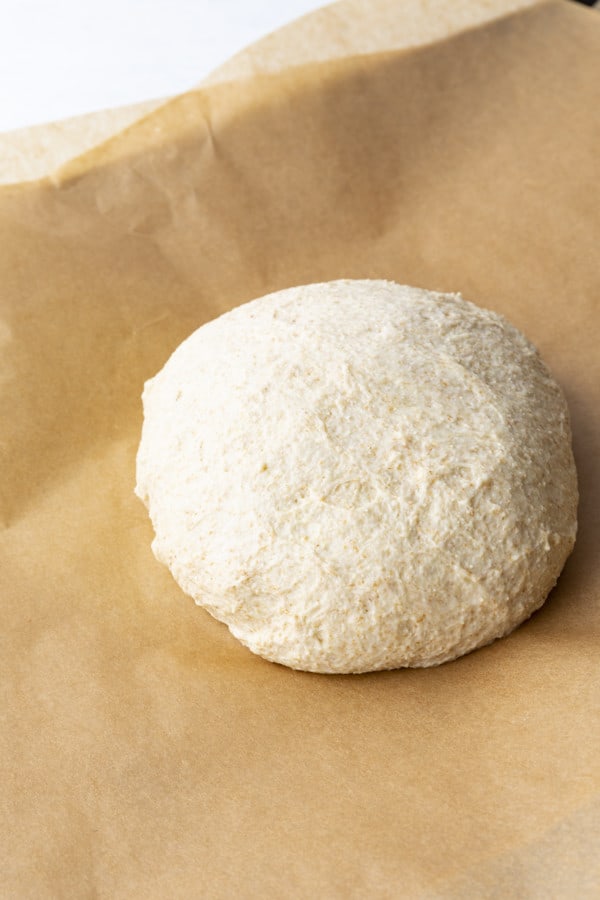
All-purpose flour is usually made from a mixture of soft and hard wheat grains. Protein levels can vary by producer, so if you find a producer you like, it’s nice to stick with them for consistent results. I’m partial to King Arthur Flour.
Semolina flour is a super-high gluten content flour that is made from durum wheat. Please don’t confuse it with rice semolina or corn semolina which are not interchangeable.
Semolina flour is used in many pastas and couscous because its high protein/gluten content makes a dough that holds its shape quite well even after cooking. It lends a nice crackle to the exterior of our Whole Wheat Pizza Dough, but keeps the inside yielding and soft as well as chewy.
Why not just use it instead of mixing it with all-purpose flour then? Well, semolina flour tends to be a little more delicate to work with when used alone.

It’s susceptible to over-kneading or over mixing, and makes a dough that tends to rip instead of stretch. Combining it with all-purpose flour helps mitigate this issue.
If you absolutely cannot find or refuse to order semolina flour (which is also delicious in our braided semolina bread), you can substitute an equal amount by volume (instead of weight) of all-purpose flour or high-gluten bread flour. It will definitely change the end product’s texture, but it will still be tasty!
And that brings us to the star of today’s pizza crust: whole wheat flour.
Whole Wheat Flour in Baked Goods
Whole wheat flour gives baked goods a richer, heartier flavour you just cannot get from white all-purpose flour. A lot of folks think that whole wheat flour makes denser baked goods, but it doesn’t need to be that way if you know a few handy tricks.

- Whole wheat flour absorbs more liquid than white flour, so whole wheat recipes need to have a little more liquid added. In general, you’re looking at adding about a tablespoon of extra water per cup of whole wheat flour.
- Because it takes a little while for the flour to absorb the extra water, your whole wheat pizza dough will start out a little stickier than one made with white all-purpose flour. Don’t add extra flour, it’ll all come right in the end. That brings us to…
- You really can’t hurry the rise time with whole wheat baked goods. While your room temperature and humidity will contribute to how fast your whole wheat pizza dough rises, you really just need to watch it. Has it doubled in bulk? If so, you’re ready to go! If not, you’re going to need to put on your patience hat and just wait it out.
- Patience is also recommended when rolling or stretching your whole wheat pizza dough.
- Remember this is not likely to rise quite as high as the equivalent amount of dough made from 100% all-purpose flour. That’s okay. That’s part of what gives it that crisp-yet-chewy texture.
Whole wheat pizza dough is the homemade pizza dough that fulfilled my pizza crust fantasy. This is crust upon which dreams are built.
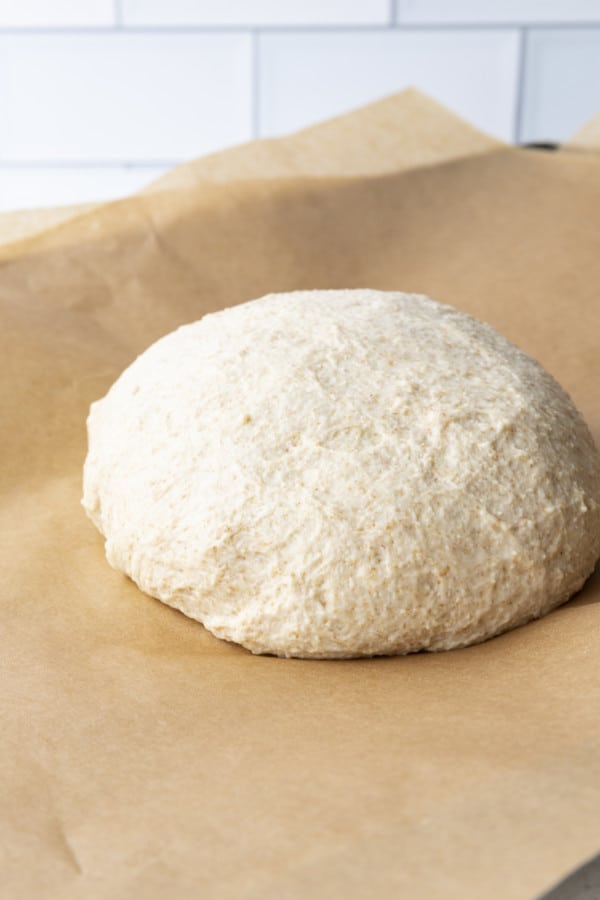
Is it hyperbole? I’ll let you be the judge. I will say, though, that every time I make this whole wheat pizza dough, my husband says “You make the best pizza dough!”
Great Pizzas to Make with Whole Wheat Pizza Crust
I’m super keen on pizza, in case you haven’t been around here long enough to notice. This recipe does make a lot of dough, but I’ve got a great many recipes this dough works for.
Of course, this whole wheat pizza crust is insanely delicious with the standard pepperoni-and-cheese toppings, but there’s so much more. You can see the Trashed Up Barbecue Turkey Pizza and Ranch Cream Cheese Vegetable Pizza as well as the-not-quite pizza-but-close-enough Pissaladière in this post.
Don’t forget our Pickle Pizza which is spectacular for pickle fans! And if experimental pizzas are your jam, go for the Smoked Salmon Cucumber Pizza.
For a pre-baked pizza crust, just roll this out, brush with olive oil, and bake at 450ºF until crisp on the bottom and golden brown to deep brown on the edges. Otherwise, use as you would any pizza dough; top and bake!
Whole Wheat Pizza Dough
This whole wheat pizza crust recipe makes enough dough for about 6 twelve inch pizzas or 3 half-sheet pan sized pizzas. I know, that’s a lot! But you don’t have to bake them all up at once.
(And if you just can’t visualize yourself eating this much pizza, the dough makes great focaccia or flatbread, too!)
Mix the yeast, salt, sugar, olive oil and water in a large capacity bucket or mixing bowl. (This recipe can be halved if you do not have a large enough container.) I love this bucket and this dough whisk for the job, but a large mixing bowl and sturdy spoon will be just fine!
Stir in the flour until no dry pockets remain. You do not have to knead it, but I find the easiest way to have it thoroughly mixed is to wet one hand and forearm and use that one to mix it in completely.
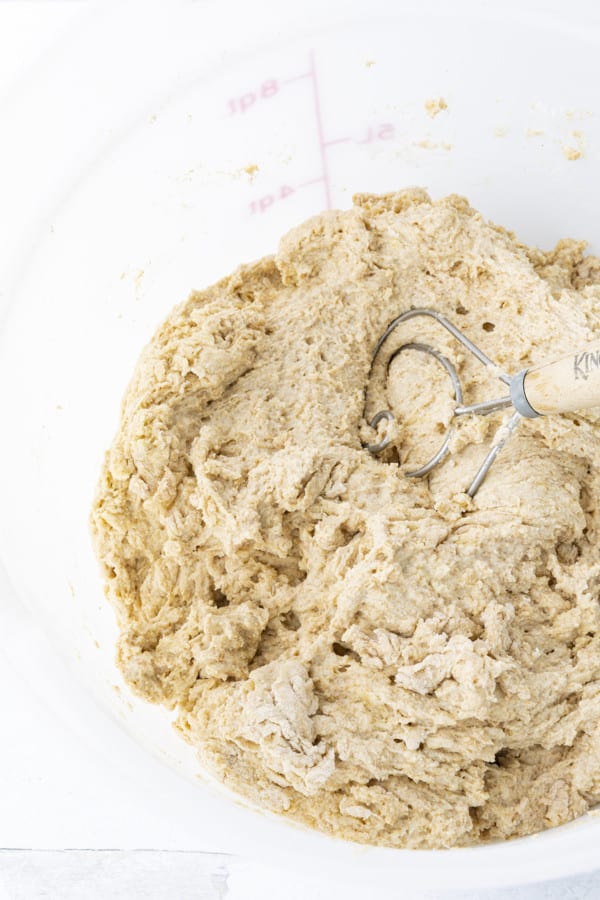
Cover lightly (Do not put a lid on tight. Trust me.) and let rest at room temperature until the dough has doubled and collapsed. (Or at least until dough is very, very puffy.) This takes a less than 2 hours in warm weather and more than 2 hours in cool or cold temperatures.
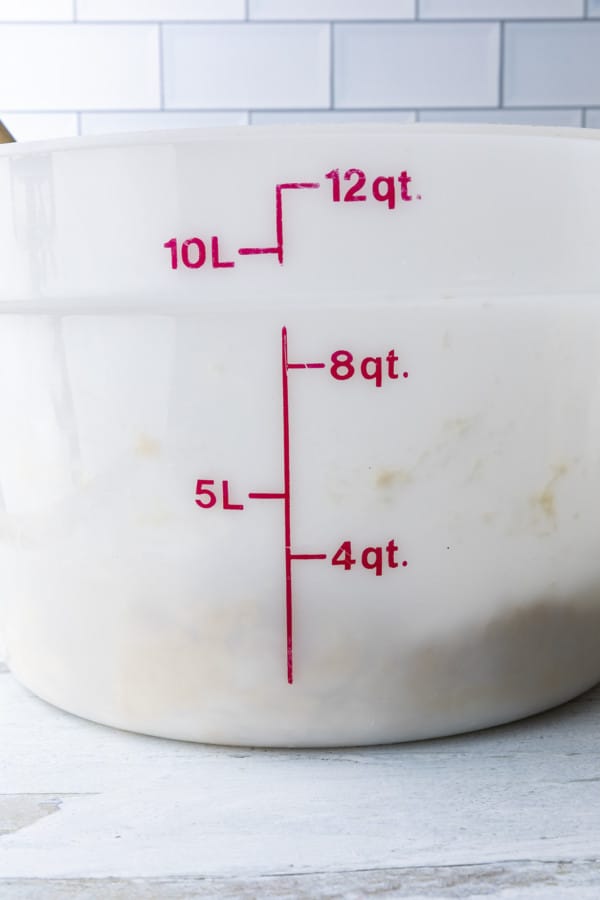
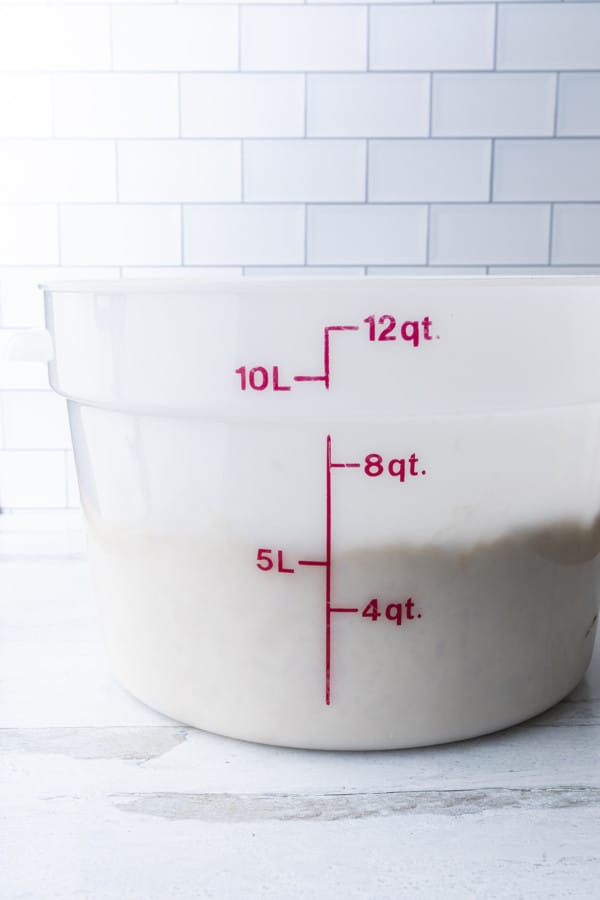
After your whole wheat pizza dough has risen to double in bulk, wet your hands and divide the dough into 6 approximately equal sized dough balls. Working with one dough ball at a time, pull the sides down from the top and tuck under the ball, rotate and repeat the process until you have a nice tight, smooth ball of whole wheat pizza dough.
Set aside the dough balls you plan to bake that night. You’ll come back to those momentarily.
To freeze your extra pizza dough for future pizza nights, grab and label a gallon sized, zip-top freezer bag for each dough ball. Drizzle a little olive oil into each freezer bag and rub it around. Drop one dough ball into each prepared bag, remove excess air from the bag, zip closed, and freeze for up to three months.
When you want to make pizza from your frozen dough, it’s easy! Simply transfer your bag of dough from the freezer to the refrigerator the 8 hours before you plan to bake it.
Let the ball of dough come to room temperature for at least 30 minutes before you plan to bake it. This will make it much easier to stretch or roll out.
You can also “quick thaw” the dough by leaving it at room temperature for about 3 hours. The thawing time will depend on how warm your home is, though!
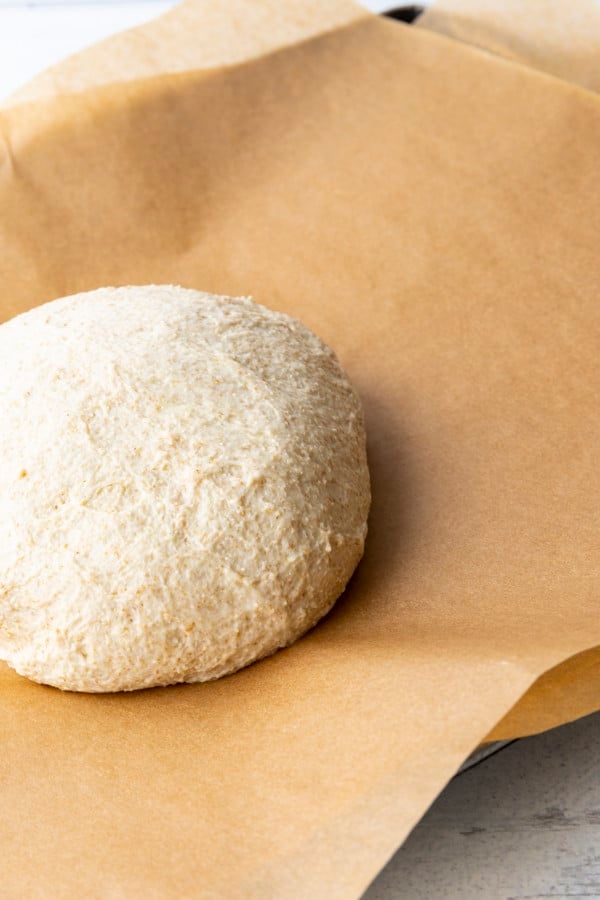
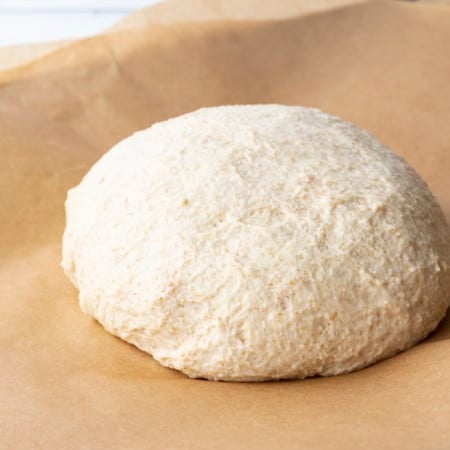
Whole Wheat Pizza Dough
Rate RecipeEquipment
- 1 dough bucket or large mixing bowl
- 1 dough whisk or long handled, sturdy spoon
Ingredients
- 5 3/4 cups room temperature water
- 1/2 cup extra virgin olive oil
- 3 tablespoons instant yeast
- 2 tablespoons kosher salt
- 2 tablespoons sugar raw or granulated
- 4 cups whole wheat flour 1 pound 1 ounce by weight
- 7 cups all-purpose flour 1 pounds, 14 3/4 ounces by weight
- 2 cups semolina flour 11 ounces by weight
Instructions
- Mix the yeast, salt, sugar, olive oil and water in a 12 quart capacity bucket. (This recipe can be halved if you do not have a large enough container.)
- Stir in the flour until no dry pockets remain. You do not have to knead it, but I find the easiest way to have it thoroughly mixed is to wet one hand and forearm and use that one to mix it in completely.
- Cover lightly (Do not put a lid on tight. Trust me.) and let rest at room temperature until the dough has doubled and collapsed. (Or at least until dough is very, very puffy.) This takes a less than 2 hours in warm weather and more than 2 hours in cool or cold temperatures.
- You can use the dough immediately. If you have leftovers, you can store them in the container, lightly covered (again, do not use a tight lid!) for up to 10 days.
- If you need to store the dough beyond that time, divide into individual pizza sized servings. Freeze in re-sealable plastic bags that have about a teaspoon of olive oil smeared around inside each for up to 3 months.
Nutrition
Nutritional information is an estimate and provided to you as a courtesy. You should calculate the nutritional information with the actual ingredients used in your recipe using your preferred nutrition calculator.
did you make this recipe?
Make sure to tag @foodiewithfam on Instagram and #hashtag it #foodiewithfamily so I can check it out!
This post was originally published May 7, 2012. Republished with improved information, instruction, and images in April 2022.
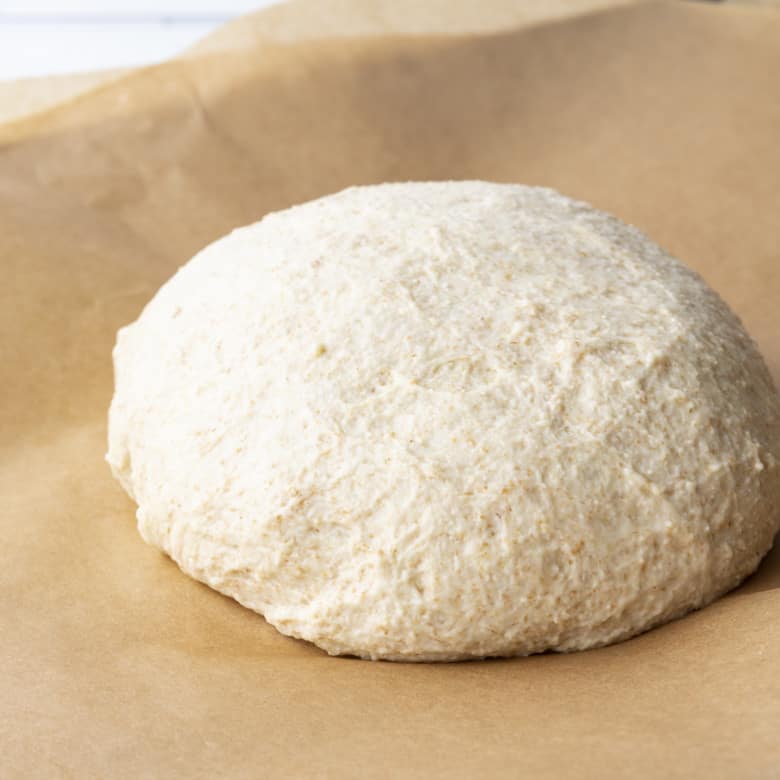



Reader's Thoughts...
Judy says
I have a couple of questions.
How large will the pizza be?
At what oven temp is it baked?
Do you bake it with the toppings on or do you pre-bake the crust before you add the sauce etc.removing it from the oven add the toppings then return to the oven for completion?
Rebecca says
Hi Judy- This is enough crust for approximately 6 twelve-inch pizzas or 3 half-sheet pan sized pizzas (as mentioned in the post). I use it in place of any other pizza crusts such as the ones I listed in the post. I have both baked it with the toppings and pre-baked it depending on what toppings I want to put on it. For instance, the cream cheese and vegetable pizza or smoked salmon pizza in the poste would require it to be pre-baked. The others would be fine to bake with toppings on it.
And I’d say 450ºF is a good starting temp for this crust, but it’s very forgiving! Bake ’til your crust is crispy on the bottom and golden brown to dark brown at the edges. 🙂
Melissa Sinclair says
I just discovered this recipe now looking for a whole wheat and semolina recipe. I was so excited to see it, but I wish there were more photos of this in process, but what I got was a soup. Now, I work with high hydration whole grain doughs all the time with making bread, but this was WAY soupy. I’m wondering if it’s because I ground my own grains? But even with the first ferment, it’s still not really able to any sort of shape, so I added more flour (all three kinds) and I’m letting it sit in the fridge for a bit to hydrate. We’ll see how it turns out, but now I’m nervous!
OK, II added some more flour and a bit of oil and salt to try to balance it out and I did a small trial batch and it’s edible with the alterations I made, but while this looked promising, this is a big “no” for me.
I weighed the ingredients too, but NOPE.
Rebecca says
Wow! That is bizarre, Melissa! I’ve never ended up with a soup on this. I have to wonder if it is an issue of home ground grains vs. commercially ground ones. I don’t use home ground grain, so I’m not sure whether it would behave differently, but if you weighed them, that’s the only issue I can think of.
The dough is definitely not a super high hydration like a good sourdough, it’s much more manageable. It’s a little on the softer side, but it’s tacky- not sticky- and totally handle-able. I’m so curious! Would you be willing to try making this with commercial flours to see if we can nail down the issue?